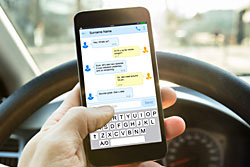Nine Eye-Opening Stats That Will Make You Rethink Texting and Driving

Nine Eye-Opening Stats That Will Make You Rethink Texting and Driving
Buzz! Buzz! You’re on your way home from work after a long day and hear the vibration of your phone. It’s your significant other wanting to know tonight’s dinner plans. You look down to start typing, but as you glance back up at the road, you realize you've drifted into the oncoming lane as a car quickly approaches. You swerve back into your lane and put your phone down. Phew! That was a close one.

Texting and driving happens every day without people truly thinking through the consequences that may come with it. Since the rise of cell phone usage and the always-connected culture of the workforce, car accidents have increased 12.3 percent. While that may be alarming, there are plenty more statistics emphasizing how much cell phone usage behind the wheel has affected safe driving.
Nine Texting-While-Driving Stats That Just Might Make You Quit:
- Texting while driving makes you six times more likely to get into an accident than those driving intoxicated.
- On average, it takes five seconds to type a text. Driving at 55 miles per hour while typing one text, you will have driven the length of a football field.2
- The chances of an accident happening on the road while someone is texting is 23 times more likely.
- Texting doubles your chance of getting in an accident.
- Texting triples your chance of crashing off-road (hitting a tree, sign, etc.).4
- You're seven times more likely to rear-end someone if you're texting.4
- Cell phone use while driving causes an estimated 1.5 million car accidents every year.4
- Cell phone use while driving kills 3,000-6,000 people every year.4
- Eleven teens die per day because of texting and driving.2
Despite all of these staggering numbers, 77 percent of adults and 55 percent of teens still believe they can easily manage texting while driving.3
Why Do People Text and Drive?
Texting and driving is not the safest choice, yet it still happens every day. People willingly partake in this unsafe act for a few psychological reasons:
- Cultural Expectations
The new age of technology has created an impatient society. With information available at the drop of a hat and the ability to talk to anyone in the world at any time, it’s hard to step back from an “immediate” mindset. People check their phone while they drive because of the sense of urgency they constantly feel, whether it be responding to their children, taking a business call, or simply checking a Facebook notification to see what is new with friends. - Dopamine
The urge to look at our phones doesn’t just come from a self-inflicted social pressure, but from a chemical response as well. When we look at our phone, our brain releases a chemical called dopamine. One of dopamine’s primary functions is motivation, essentially rewarding us for most beneficial behaviors to encourage us to repeat them. This is the same feeling we get after we eat food, work out, and have successful social interactions. It is also associated with addiction. The release of dopamine we experience when hearing the notification from our phones makes it hard for us to resist looking. - Reinforcement
Just like B.F. Skinner and his rats who realized if they hit the lever, food would fall into their bowl, humans are subject to positive reinforcement. Every time we look at our phones or send a text while driving, and nothing happens to us, we are encouraged to do it again. The more times we do it without receiving any type of negative consequence, we believe the same result will continue to occur.
Prevention Programs
Considering how so many people are taking part in this dangerous habit, phone companies were bound to take action against such a significant problem their products directly cause.
In 2010, AT&T started a campaign called “It Can Wait.” This campaign was used to drive awareness to the issue of texting and driving. To spread awareness, they created a pledge people could sign to promise they would never let their phone endanger them while driving. This campaign became so powerful, a whole movement began.
In 2012, AT&T expanded their campaign to be more interactive. They started bringing simulation equipment to events for people to see first-hand what it’s like to text and drive, in addition to how much it affects their reaction time and focus.
By 2013, AT&T began an advocacy program where people spoke about their accidents or their loved ones’ accidents that could have been prevented had they not looked at their phone. The movement was so powerful, it caused majority of the phone companies, including Verizon and T-Mobile, to come together and support the cause as they looked at the big picture.
Tips and Tricks for Avoiding Texting and Driving:
If you feel as though you’re a culprit of texting and driving and want to divert from your previous ways, there are some simple solutions and actions you can take to keep your hands off the phone and your eyes on the road.
- Silence your phone—that includes vibration too!
- Keep your phone out of reach.
- If it is an emergency, pull over and proceed.
- Utilize anti-texting and driving apps.
A few of the top rated apps:
- AT&T Drive Mode
This app automatically turns on when the car starts moving. It silences all incoming texts while also sending an automatic response to tell the person contacting you that you’re driving. - OMW!—On My Way!
Instead of trying to text friends and family how soon you’ll be there, this app allows you to share your trip plan with them. They can follow along with your journey and see your estimated time of arrival. - Down for the Count
This app is designed to reward young drivers who practice safe driving. They take a pledge and get others, such as parents or relatives, to sponsor them. The sponsors then chip in every time the driver is practicing safe habits.
Parents with Adolescent Drivers:
- Understand you set an example for your children. If they see you doing it, they will think it is okay for them to do it too.
- Use an app that allows you to see their phone usage while they drive. This will hold them accountable for their actions knowing that you can see how safe they are being.
- Lifesaver
It gives you, as a parent, the power to lock your kid’s phone while the car is in motion. When the car stops, the phone will unlock and be fully functioning. - Canary
Allows a parent to track their child as they drive. It reports everything from phone usage to speed to location. You’re practically there with them!
With these numbers, we can see the impact texting while driving has on our society and youth. Fortunately, companies, organizations, and those who have been impacted by these habits have provided great resources to limit the distractions we see while driving.
Remember, it can wait.
Sources
1. Business Wire, The Rise of the Always Connected Mobile Workforce. 2018.
2. Drivers Alert, 10 Terrifying Facts About Texting and Driving, 2018, https://www.driversalert.com/10-terrifying-facts-about-texting-and-driving/
3. Teen Safe, 100 Distracted Driving Facts & Statistics for 2018, 2018.
4. Miller and Zois, 2019 Texting and Driving Statistics, 2019.
5. Psychology Today, Dopamine, 2018
6. Simply Psychology, Skinner—Operant Conditioning, 2018, https://www.simplypsychology.org/operant-conditioning.html.
7. Fleishman Hillard, It Can Wait—The Power of a Movement, 2018, https://fleishmanhillard.com/work/att-can-wait-power-movement/
You might also be interested in...
-
 10 Signs You May Not Be Drinking Enough Water
10 Signs You May Not Be Drinking Enough Water
-
 8 Signs You May Not Be Getting Enough Magnesium
8 Signs You May Not Be Getting Enough Magnesium
-
 About Life Insurance
About Life Insurance
-
 Do You Really Need Life Insurance?
Do You Really Need Life Insurance?
-
 Does Divorce Spell The End Of A Happy Childhood
Does Divorce Spell The End Of A Happy Childhood
-
 Globe Life is Rated A (Excellent)
Globe Life is Rated A (Excellent)
-
 Health Symptoms You Should Never Ignore
Health Symptoms You Should Never Ignore
-
 History of Life Insurance
History of Life Insurance
-
 Home Cough Remedies
Home Cough Remedies
-
 How High Should Your SPF Be
How High Should Your SPF Be
-
 How To Be Responsible About Life Insurance
How To Be Responsible About Life Insurance
-
 Is Eating Organic Really Safer?
Is Eating Organic Really Safer?
-
 Is White Vinegar A Safe Cleaning Agent?
Is White Vinegar A Safe Cleaning Agent?
-
 Planning Your Family For An Emergency Evacuation
Planning Your Family For An Emergency Evacuation
-
 The Difference Between Power Of Attorney And A Living Will
The Difference Between Power Of Attorney And A Living Will
-
 Reconsider Getting a Life Insurance Policy
Reconsider Getting a Life Insurance Policy
-
 Setting Goals For Your Employees
Setting Goals For Your Employees
-
 Skills that Make Bosses Want to Hire You
Skills that Make Bosses Want to Hire You
-
 The Importance of Life Insurance
The Importance of Life Insurance
-
 The Importance of Term Life Insurance
The Importance of Term Life Insurance
-
 Is It Time To Review Your Life Insurance Policy?
Is It Time To Review Your Life Insurance Policy?
-
 Tips On How To Prevent E.coli
Tips On How To Prevent E.coli
-
 Too Busy to Stay Healthy?
Too Busy to Stay Healthy?
-
 What Is COPD And How You Can Prevent It?
What Is COPD And How You Can Prevent It?
-
 What is Term Life Insurance?
What is Term Life Insurance?
-
 When Insurance Becomes an Investment
When Insurance Becomes an Investment
-
 Choosing Whole Life Vs Term Life Insurance
Choosing Whole Life Vs Term Life Insurance
-
 Why You Should Look Into Term Life Insurance
Why You Should Look Into Term Life Insurance
-
 Making Your Home Senior-Friendly
Making Your Home Senior-Friendly
-
 Is Whooping Cough Making A Comeback
Is Whooping Cough Making A Comeback
-
 Unusual Tricks To Reduce The Risk Of Heart Disease
Unusual Tricks To Reduce The Risk Of Heart Disease
-
 The Best First Aid Kit Everyone Should Have
The Best First Aid Kit Everyone Should Have
-
 Beware Of Dangerous Mold
Beware Of Dangerous Mold
-
 5 Things You Should Know About Thyroid Health
5 Things You Should Know About Thyroid Health
-
 What Your Eyes Reveal About Your Health
What Your Eyes Reveal About Your Health
-
 Everyday Things That Can Cause Memory Loss
Everyday Things That Can Cause Memory Loss
-
 How To Discuss Life Insurance With Your Spouse
How To Discuss Life Insurance With Your Spouse
-
 Why That Cold Won’t Go Away
Why That Cold Won’t Go Away
-
 5 Ways To Keep A Healthy Smile
5 Ways To Keep A Healthy Smile
-
 How Dangerous Is Sugar?
How Dangerous Is Sugar?
-
 5 Warning Signs To Change Healthcare Providers
5 Warning Signs To Change Healthcare Providers
-
 Simple Secrets To Conquer Flu Season
Simple Secrets To Conquer Flu Season
-
 The Hidden Bad Side Of Everyday Foods
The Hidden Bad Side Of Everyday Foods
-
 How To Avoid The Scams That Tricked So Many
How To Avoid The Scams That Tricked So Many
-
 Six Foods That May Reduce Stroke Risk
Six Foods That May Reduce Stroke Risk
-
 Empty Nesters: Don’t Ditch Life Insurance Until You Consider This
Empty Nesters: Don’t Ditch Life Insurance Until You Consider This
-
 How Does Accidental Death Insurance Work?
How Does Accidental Death Insurance Work?
-
 4 Tips To Improve Your Credit Score
4 Tips To Improve Your Credit Score
-
 6 Tech Devices You Need For Family Safety
6 Tech Devices You Need For Family Safety
-
 Public Transportation Safety Tips
Public Transportation Safety Tips
-
 Is Globe Life Insurance Reliable?
Is Globe Life Insurance Reliable?
-
 Hazards in the Kitchen: What You Do Every Day that Puts You at Risk for a Serious Accident
Hazards in the Kitchen: What You Do Every Day that Puts You at Risk for a Serious Accident
-
 Surviving a Snake Bite
Surviving a Snake Bite
-
 Is Globe Life Insurance Term or Whole Life?
Is Globe Life Insurance Term or Whole Life?
-
 The Top 4 Leading Causes of Death for People Older Than 50 and How to Avoid Them
The Top 4 Leading Causes of Death for People Older Than 50 and How to Avoid Them
-
 Nine Eye-Opening Stats That Will Make You Rethink Texting and Driving
Nine Eye-Opening Stats That Will Make You Rethink Texting and Driving
-
 Risks of Dying from Cancer
Risks of Dying from Cancer
-
 What are the Odds of Dying While Taking a Selfie?
What are the Odds of Dying While Taking a Selfie?
-
 Can I Get an Accidental Death Quote Online?
Can I Get an Accidental Death Quote Online?
-
 Buying Life Insurance for the Whole Family
Buying Life Insurance for the Whole Family
-
 What You Need to Know Before Buying Term Life Insurance
What You Need to Know Before Buying Term Life Insurance
-
 Advantages and Disadvantages of Getting Life Insurance without a Medical Exam
Advantages and Disadvantages of Getting Life Insurance without a Medical Exam
-
 A New Year's Resolution You Can Keep: Buy Life Insurance
A New Year's Resolution You Can Keep: Buy Life Insurance
-
 Food Contamination: Ways to Avoid the Potential Dangers and Keep Food Safe
Food Contamination: Ways to Avoid the Potential Dangers and Keep Food Safe
-
 Can I Increase the Face Value of My Term Life Insurance?
Can I Increase the Face Value of My Term Life Insurance?
-
 What is Mortgage Protection Insurance?
What is Mortgage Protection Insurance?
-
 Do I need Accidental Death Insurance?
Do I need Accidental Death Insurance?
-
 How Does a Graded Death Benefit Whole Life Insurance Policy Work?
How Does a Graded Death Benefit Whole Life Insurance Policy Work?

 Insurance products are available in New York from
Insurance products are available in New York from  Insurance products are available in your state from
Insurance products are available in your state from 









































































